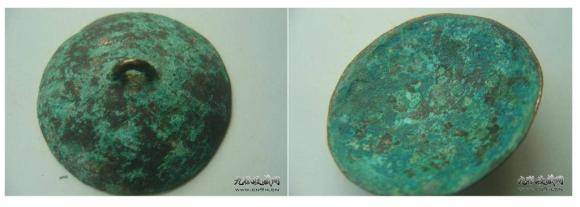
Yang-sui, in a need of a good polishing
One of the great stories from ancient history is of Archimedes Burning Mirrors. Legend has it that Archimedes designed a series of curved mirrors to reflect and focus the rays of the sun and that these mirrors were used to set a fleet of Roman ships on fire during the Siege of Syracuse in 214–212 BC. Historians have often dismissed the story as a fanciful folk-tale. In January of this year, however, we posted of a modern, if accidental version of the burning mirrors in the form of London’s “Walkie Scorchie,” a glass office tower whose curved surface has been reflecting focussed sunlight, and has melted cars and fried eggs on the sidewalk. A month later we also posted about a very intentional version of the “burning mirrors” at the Ivanpah Solar Thermal Power Facility, which is currently the world’s largest solar thermal power system.
Recently, author John Perlin wrote the discovery of Bronze Age Chinese hand-sized “burning mirrors” in his book Let It Shine: The 6,000-Year Story of Solar Energy. Perlin writes: During the sixth century BCE, Confucius wrote about the common use of curved mirrors shaped from shiny metal to concentrate the rays of the sun for making fire. These became known as yang-suis – translating to solar ignitors, or burning mirrors.
According to the great philosopher, upon waking up the eldest son would attach a solar ignitor to his belt as he dressed for the day. It was his duty to focus the solar rays onto kindling to start the family’s cooking fire.
According to another early text, the Zhouli, which describes rituals dating far back into Chinese antiquity, “The Directors of the Sun Fire have the duty of transferring with burning mirrors the brilliant flames of the sun to torches for sacrifice.”
Although scholars found over the years many ancient texts discussing solar ignitors, the discovery of an extant yang sui eluded them for centuries. Quite recently came the Eureka moment. Digging up a tomb that dated to about three thousand years ago, a team of archaeologists found in the hand of a skeleton a bowl-shaped metal object. While the inner side could have passed for a wok, the exterior trough had a handle in its center. That’s what caught the eye of the two archaeologist in charge of the dig, Lu Demming and Zhai Keyong. They immediately brought the relic back to the local museum and ordered its specialists to make a mold from the original and then cast a copy in bronze.
